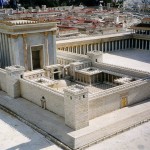Tabernacle or Temple? – T’rumah
Usually people say that each one reflected the circumstances of the time – during the trek through the wilderness a movable sanctuary; when they settled into the Promised Land, a permanent site with a fixed building.
True, the Temple was grander and more impressive than the Tabernacle, but that is natural when an edifice is expected to stand for a lengthy period or for ever. When the Temple was destroyed, both by the Babylonians and by the Romans, the people went into mourning, but when the Tabernacle was no longer needed it could fade into history.
Nonetheless the memory of the Tabernacle turned out to be a great asset to the people. They had a fear: “Until the Temple is rebuilt how are we going to manage?” With this fear came another: “How will we cope now that we have to move from place to place?”
Both fears were allayed by thinking of the Tabernacle: “We can take our sanctuary with us”. Not in the sense of a building, but a portable focus, Torah, prayer and good deeds, which enabled them to be Jews wherever they were.
Evidence? Look at what Jews did wherever they found themselves, even on the move, even in ghettoes, even in the Nazi camps – they learned Torah, they prayed, they remained true to their moral principles.
It was never easy. Some rebelled: “How can God put us through this suffering?” But in the end they ensured that Judaism would survive to face another day.




